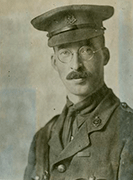The Second Battle of Ypres and the first chlorine gas attack
April 9, 2015
A terrifying chapter in modern warfare began on April 22, 1915, when German troops released 160 tons of chlorine gas at the Second Battle of Ypres. The wind carried the massive greenish-yellow cloud towards unsuspecting Allied soldiers, who were forced to flee while coughing, choking and dying. Remarkably, Canadian and British troops were able to close the gap and stop the German advance, and Allied forces ultimately prevailed in the month-long fight for Ypres.
“That first devastating chlorine gas attack 100 years ago launched a chemical arms race, as well as a parallel race to protect soldiers against asphyxiation, damaged lungs, blindness and burns,” says Dr. Mélanie Morin-Pelletier, a First World War historian and curator of the Canadian War Museum exhibition Fighting in Flanders – Gas. Mud. Memory.
Captain Francis Scrimger (1880–1937), a physician from Montréal who commanded a medical station near Ypres, was among the first to identify the gas as chlorine. He instructed soldiers to cover their mouth and nose with a damp cloth, which offered limited protection. Scrimger’s bravery and devotion to his patients during the Second Battle of Ypres earned him a Victoria Cross, now part of the Canadian War Museum’s collections and on display in the exhibition.
“‘Scrim’ or ‘Scrimmy,’ as he was called, served out the war in England, Belgium and France, and rose to become chief surgeon at No. 3 Canadian General Hospital,” says Morin-Pelletier. “In 1918, he married Nursing Sister Ellen Carpenter, one of his operating room nurses. After the war, he returned to Montréal to practice and teach medicine, and earned a reputation as one of Canada’s finest surgeons.”
A new kind of warfare
As the First World War raged on, the Germans and Allies each developed new chemical weapons and ever more effective ways to release them. With tear gas grenades and chemical bombs, they could target the enemy with precision rather than wait for favourable winds to carry gas in the right direction.
With no effective treatments for many gas-related injuries, both sides scrambled to develop protective gear that would let soldiers fight through clouds of chlorine, phosgene and mustard gas. Gas masks evolved from simple urine-soaked cloths to sophisticated and effective respirators.
Training exercises in gas-filled huts helped soldiers face the new threat with more confidence, while gas alarms alerted soldiers to don their masks in time to avoid breathing in the toxic chemicals. Even horses, essential for transporting supplies and pulling guns, were equipped with gas masks.
“The Second Battle of Ypres was a watershed in modern warfare,” says Morin-Pelletier. “Chemical weapons were not the deadliest weapons First World War soldiers faced, but they were among the most terrifying and traumatic.”
Fighting in Flanders – Gas. Mud. Memory. is at the Canadian War Museum until April 26.
Image: Lieutenant Colonel Francis Alexander Coran Scrimger, VC
CWM 19940079-097 George Metcalf Archival Collection, Canadian War Museum